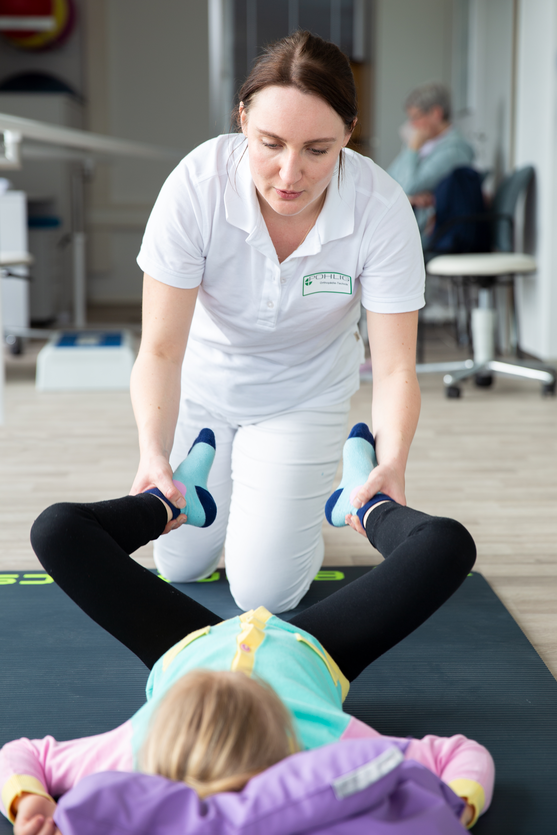The Orthopedic Children’s Clinic in Aschau is one of the largest specialist clinics for pediatric orthopedics in Central Europe.
When it comes to orthopedic treatment for infants and children, it is extremely important for all parties to pull together: parents, doctors, technicians and therapists.
Physiotherapists support the individual care of our little patients at our headquarters.
Definition
What is a hip dysplasia?
The hip joint connects the pelvis to the thigh. Because the head of the hip joint, which is located at the upper end of the thigh bone, has a round shape and is more than 50% surrounded by the acetabulum, it is a so-called nut joint (a special form of the ball and socket joint).
Hip dysplasia is a congenital or acquired malformation of the acetabulum. In this case, the acetabulum is not large or deep enough to grip the femoral head well. As a result, the femoral head no longer lies stably in the acetabulum. In severe cases, the head of the femur can thus no longer be held centered and slides upward out of the socket (hip dislocation). Both sides of the hip can be affected, as well as only one side. In addition, girls are affected significantly more often than boys.
Infantile hip dysplasia is a congenital maturation disorder of the hip joint. Mild hip dysplasia does not necessarily cause symptoms. However, if the deformity is not recognized in time or if it is inadequately treated, it can lead to a permanent deformity of the head and the socket, as well as to hip luxation. Pain caused by hip dislocation can lead to loss of the ability to stand and walk. Patients who rely on wheelchairs may have limited ability to sit. There is also a risk that existing scolioses, i.e. lateral curvatures of the spine, will increase.
As a late consequence of hip dysplasia, joint diseases such as osteoarthritis of the hip joint can occur. In osteoarthritis, the cartilage at the joint wears away, which can lead to severe pain and limited movement.

Causes
This is how hip dysplasia occurs
If one investigates possible causes for hip dysplasia, one comes across various reasons, which can be genetic, hormonal and mechanical.
First of all, the deformity of the acetabulum may be inherited. The risk of developing hip dysplasia increases tenfold as soon as one parent is affected.
Furthermore, the pregnancy hormone progesterone, which causes the loosening of structures in the mother's pelvic ring, can probably also cause loosening of the hip joint capsule in female fetuses.
Other causes of hip dysplasia can be mechanical, for example in the case of a lack of space or amniotic fluid in the womb or if the unborn child is breech. Multiple pregnancies can also promote hip dysplasia.
Finally, there is the possibility that pre-existing malformations in the spine, legs and feet, as well as neurological or muscular diseases, may lead to (secondary) hip dysplasia.
Symptoms
How can you recognize hip dysplasia?

In principle, the presence of hip dysplasia is checked by the doctor by ultrasound examination (sonography) as part of the preventive medical checkups. If you are unsure, you are welcome to ask your doctor about this.
One sign of hip dysplasia that you can check yourself is the length of your baby's legs. An indication of a congenital hip deformity is a difference in the length of the legs. If your baby's legs do not spread evenly to the side or if the buttocks are at a different height, this may indicate hip dysplasia. When walking, infant hip dysplasia often shows up in a limp or waddle gait.
For a better overview, here are the main symptoms of hip dysplasia:
- Leg length discrepancy
- Abduction of the legs
- Postural asymmetry
- Pelvic uprightness on the affected side
- compensatory curvature of the spine to the opposite side
- torticollis posture to the opposite side
As a late consequence of hip dysplasia, joint diseases such as hip joint arthrosis can occur. In osteoarthritis, the cartilage at the joint wears away, which can lead to severe pain and limited movement.
Infantile cerebral palsy (ICP)
How are ICP and hip dysplasia or hip joint decentration related?
In contrast to congenital hip dysplasia, the hips of patients with infantile cerebral palsy (ICP) are usually inconspicuous at birth. However, in order for the hip to develop undisturbed in an infant, verticalization, i.e. straightening onto two legs, must occur in a timely and developmentally appropriate manner. Walking and standing thus play an important role in centering the hip joint.
Decentering of the hip joint in ICP patients is mainly caused by:
- increased muscle tone
- muscular imbalance
- contractures
- growth
- insufficient movement variations
- missing or not age-appropriate strain
Therefore, any spastic hip that is neither muscularly balanced nor developmentally appropriately loaded should be considered at risk for dysplasia and should be monitored by a physician at regular intervals.
Conservative or surgical?
Treatment options
The treatment options for hip dysplasia depend on the severity of the deformity. Basically, a distinction is made between conservative and surgical treatments:
Conservative treatment is therapy that does not intervene in the body. This includes physiotherapy and orthopedic technical aids such as orthoses. Both physiotherapy and orthopedic and rehabilitation technology have a wide range of options for treating infantile hip dysplasia to accompany medical therapy.
If hip dysplasia is detected too late or if satisfactory roofing of the femoral head has not been achieved despite conservative efforts, hip surgery may be required. After surgery, a cast or orthotic treatment is usually required. Positioning elements may also be considered postoperatively.
Hip dysplasia in children with ICP
Treatment without surgery
A main goal in the conservative treatment of children with ICP is the prevention of deformities at the joint and hip dislocations. Various therapeutic approaches play a role here, such as positioning treatment with the aid of positioning orthoses or positioning elements, physiotherapy and the injection of botulinum toxin (Botox).

If mild hip dysplasia is present, wide wrapping of the child is often sufficient, as the hip joint is still relatively malleable in infancy. Wide wrapping allows the hip joint to be held in a splayed and hip flexed position - that is, a position in which the hip joint can best mature and the femoral head can adjust deeply into the acetabulum.
Treatment with a so-called spreader trouser, spreader splint or positioning orthosis is carried out for moderate hip dysplasia. In collaboration with the Aschau Children's Hospital, we have succeeded in developing a new type of dynamic abduction orthosis for the hip. The PHAO (Pohlig Hip Abduction Orthosis) keeps the hips in the medically required abduction position at night. In doing so, it restricts the mobility of the hips and knee joints only as much as absolutely necessary. The PHAO is equipped with a free-moving knee joint that allows knee flexion at all times. Using a specially developed multi-joint mechanism, a gas pressure spring brings the hip joints into the required splayed corrective position. In the event of spasticity or when the child turns over on its own, the spring yields and allows the legs to be adducted (bent) for a short time. When the musculature relaxes again, the gas pressure spring pushes the legs apart again, thus restoring the desired spread in the hip.
Another component of the conservative treatment of hip dysplasia is the positioning treatment using individually manufactured positioning elements. In order to optimally position children with hip dysplasia in the supine position, we manufacture individual elements that can be made for supine, lateral and prone positions. As with PHAO, abduction of the legs while lying down ensures that the hip joints are set centered in the socket.

In addition to medical treatment, it is recommended that the affected child receives physiotherapeutic treatment. With the help of neurophysiological treatment (e.g. Bobath concept, Vojta therapy) and various osteopathic techniques, positional asymmetries and muscular imbalances can be positively influenced. Physiotherapy on a neurophysiological basis focuses on the following measures, among others:
- stretching of the shortened muscle groups
- activation of the opposing muscles, hip extensors and abductors
- verticalization
Especially in severely affected children, passive uprighting in standing should be made possible at an early stage to ensure stimulation of the hip joints. When standing in a standing stand and sitting in a wheelchair, care must be taken to ensure adequate abduction, i.e., spreading of the legs away from the body. This helps to prevent internal rotation and adduction of the hip.

Let yourself be inspired! We follow many interesting patients during their Pohlig appointment and give you personal insights.

For those who want to delve even deeper into the subject, we have a suitable video for almost every area of treatment!

Take a look behind the scenes at Pohlig and learn about different health conditions and our innovative assistive technology solutions!

Sometimes funny, sometimes explanatory, sometimes emotional - but above all always entertaining: our videos on TikTok!
PHAO
Hip abduction during sleep
PHAO offers completely new perspectives for affected patients and their caregivers. Because nighttime assistance with turning becomes obsolete, the quality of sleep for the entire family improves. Patients who need to be turned are also more mobile and not bedded down in a rigid system.


